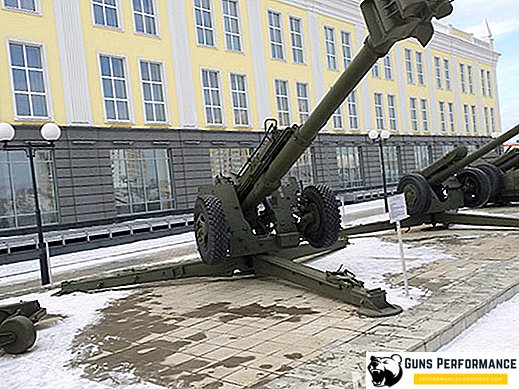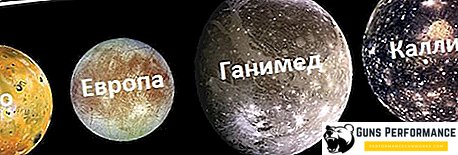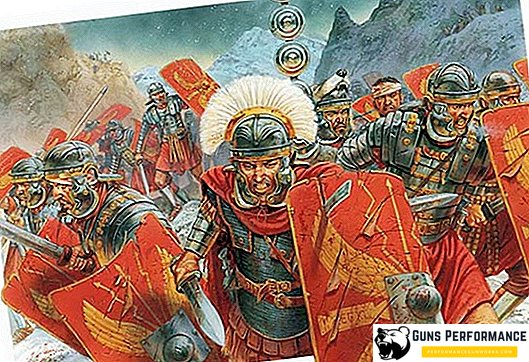
The Roman Empire reached its greatness and power thanks in large part to its legions. Victory to ancient Rome was brought to the battlefield by Roman infantry, who perfectly mastered melee techniques. The short, double-edged sword the gladius in the hands of the Roman legionnaire became the pivot on which the entire military machine of the mighty ancient state held.
History tour
Another Roman chronicler Titus Livius (I century BC - the beginning of the I century AD) described in his writings the action of Roman soldiers on the battlefield. The main tactics of the battle were based on collective actions. The legionary system was a series of closed shields, followed by a line of soldiers. The first and main blow to the enemy was delivered with the help of darts. Short spears rushed into the ranks of enemies, inflicting their first serious losses. After this, melee fighting began, where the main emphasis was placed on melee techniques.
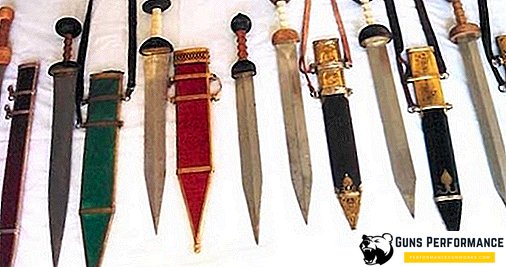
The main melee weapon of the Romans was the sword. With his help, the soldier could decide the outcome of the martial arts in his favor, wounding or killing the enemy. The Roman gladius in this regard was an indispensable weapon. The combat characteristics of cold weapons in those times were determined by the following aspects:
- the weight of the weapon;
- the size of the weapon;
- strength of the warhead;
- presence of piercing and cutting edges.
Before the Romans, the battle was mainly conducted with a spear, the sword had defensive functions and was used in extreme cases. Military reforms Maria (157 BC - 86 BC) made the soldier a perfect universal fighting mechanism of the Roman army. Legionnaires equally well mastered spear, sword and shield. Before the Romans, only the Greeks were actively using swords on the battlefield, but the effectiveness of the combat use of this type of knives was limited. The bronze swords of the Greeks were too short and did not have high strength characteristics.
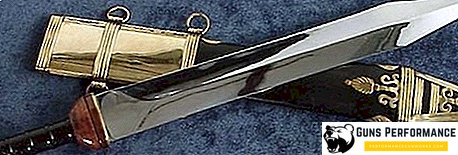
The Romans were the first to equip their swords not only with a cutting edge, but also to add a point to the weapon. The first mention of the combat capabilities of Roman swords falls on the III-II century BC. In this form, a short sword became a dangerous and universal fighting means capable of inflicting stabbed and cutting wounds on the enemy. Great importance was attached to the skill of owning a sword during close combat. In this aspect, the Roman legionaries had no equal on the battlefield.
Appearance of gladius

The Roman army, not having numerous cavalry and recruited in most cases from the poor strata of Roman citizens, relied on the combat capabilities of the infantry. The main task that stood before the Roman legions was to preserve the order of battle and build, deliver a stunning first blow to the enemy. Then came the swords, which caused great damage to the enemy during direct contact. Gladius allowed Roman soldiers to simultaneously strike and slash the enemy at close range, in a tight and close fighting mass.
Initially, the weapon was made of low-grade metal, since it was not possible to equip a large army with first-class combat blades for either technical or financial capabilities, therefore Roman swords are often called the most democratic weapon that became the main weapon of the ancient Roman infantry. Despite the low quality of manufacture, Roman swords in large quantities were sent to the troops. Due to the ease of manufacture and low cost, it was easy to compensate for the loss of military equipment and equip new military formations with such weapons.

Legionnaires massively armed with gladiuses, which were equally effective for close combat and martial arts. The size of the weapon ensured its successful use both in land combat, during the assault, and during boarding battles at sea.
Gladius was firmly established as the main military weapon of the Roman soldier after the conquest of Spain. The first successful fighting of the Roman army with the Spanish tribes, as well as the battles of the First Punic War proved the correctness of the choice in favor of short swords.
The sword got its name because of its shape. This is a straight, short blade with a smooth blade. In the weapon due to the presence of a spherical tip of an increased size, the center of gravity is shifted. This design of the sword makes it quite easy to use. Unlike other types of cold arms, Roman swords allowed the soldiers to save their own strength and for a long time was in the ranks.
The warhead has a point that provides weapons with a large penetrating ability. Fatal stab wounds could be inflicted with a sword, but the presence of cutting edges on the blade made it possible for the Legionnaires to inflict slashing and distracting blows. For a closed system, the main combat tactics were thrust strikes with attacks, so it was just this form of blade and the length of the blade that was convenient.
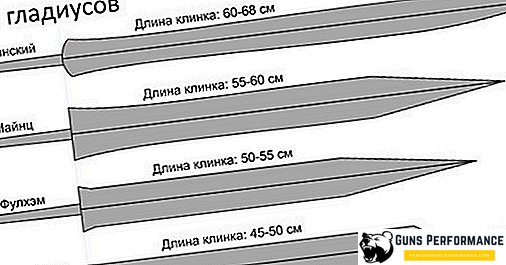
In comparison with the swords of other tribes and peoples, the Roman sword was significantly inferior in length and in striking action. However, the skillful possession of the Roman legionnaires by the principles of close combat compensated for the insufficient tactical and technical characteristics of the gladius.
In the future, a compromise was found. Spata, a weapon combining the properties and qualities of Roman swords with the blades of barbarian tribes, appeared on the arms of the Roman infantry.
Martial characteristics
The Roman swords that have reached our times are made by forging. There are references to bronze products, but the bulk of the weapon was iron. The main historical period, which accounted for the intensive use of the gladius, falls on the era of the Roman Republic and the formation of the empire. In different historical periods, the use of short swords of one modification or another was noticed by Roman soldiers in a battle.

Those samples of swords that have reached our days are steel blades 65–85 cm long and 4–8 cm wide. The sword weight usually varied within 1.5 kg.
Each era imprinted on the combat equipment of the Roman army. Roman legionaries took over the best from their opponents, making adjustments to the tactics of combat and modernizing their combat equipment. Do not stay aside and the main Roman sword - gladius. At various times, the Romans were armed with four main types of swords:
- bilbo;
- Mainz;
- fulham;
- gladius pompey.
All four types are distinguished by the length of the blade, its shape, time and geographical conditions of use.
The most common type of Roman swords, which has been used by legionaries for almost three centuries, is the Spanish gladius. The blade has a length of 75-85 cm, which is the largest size for a weapon of this type. The blade has a straight shape with a pronounced tip. Weighed such weapons up to 1 kg.
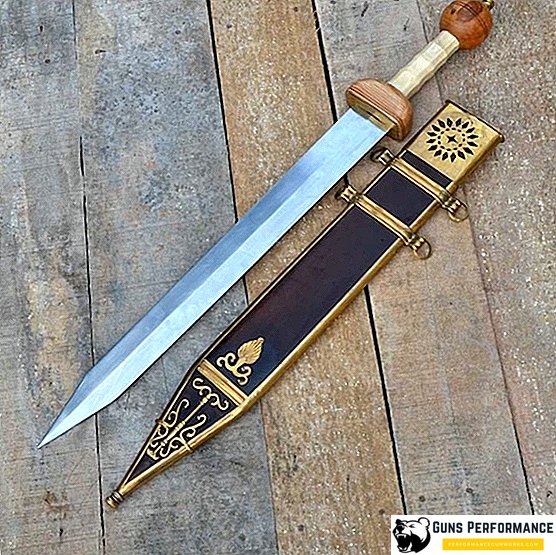
The next type of Roman sword, which was in service with the legionnaires in the conquest of Europe, was mainz. The sword is named after the German city of Mainz, in which samples of these weapons were found. This type already carries in itself the features of the German edged weapons, which armed the barbarian tribes on the Upper Rhine. Weapons were used in the late period, at the turn of the millennium, up to the III century AD.
The sword was shorter than Spanish by 10-15 cm. The samples that were found during the excavations were 65-70 cm long. There are samples of swords with a short blade, only 50-55 cm. The width of the warhead is only 7 cm. Mainz "even smaller, up to 800 grams.
The third type of Roman swords - fulham, is intermediate. The name of the weapon was due to the fact that the samples were found in the territory of Southern England, near the city of Fulham. The weapon has strict geometric shapes and lines. The blade is distinguished by straight cutting edges, a geometrically sustained corner of the tip at 25 degrees.
Swords gladius of the fulham type have a length of 65-70 cm. The width of the blade is about 6-7 cm, so this type can be considered the narrowest of all four types. The combat sword in this version weighs 700 grams. The combat use of weapons of this type falls on the first century of our era, when the Romans began to conquer the British Isles.
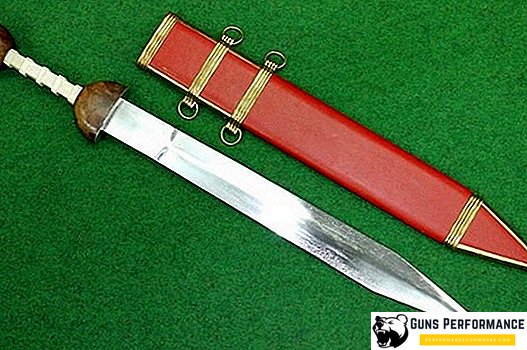
The latest type - the Pompeian gladius is a weapon that has become widespread in the last years of the Roman Empire. The blade got its name because the first samples were found during excavations at the site of existence of the ancient Roman city of Pompeii. In appearance, this type is the most perfect product, which indicates its late appearance in service of the Roman army. Unlike previous types of Roman swords, the Pompeian gladius is light and thin. The tip has a small angle, adding to the weapon as much as possible. The samples found suggest that the swords were short, 60-65 cm with a blade width of 5 cm. This blade weighed just over 700 grams this type of swords was used in the Roman army until the V century AD, when the Roman Empire was in decline .
Conclusion
Gladius has become synonymous with any sword, which is in service with the Roman legions. New technologies in metallurgy led to the fact that metals of better quality began to appear. In place of the traditional swords with a simple and unpretentious form, it has come a more advanced weapon. Powerful and long blades became the main weapon of medieval knights. The sword became the weapon of rich, wealthy warriors. The transition from a regular mass army to the formation of military militia was the reason for the transition to other, cheap types and types of knives.


